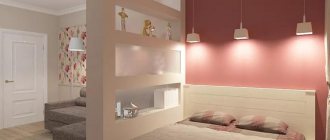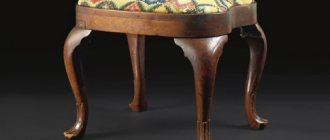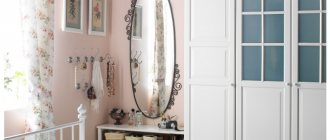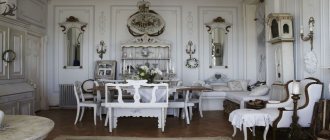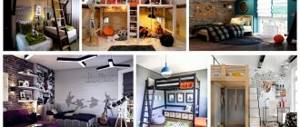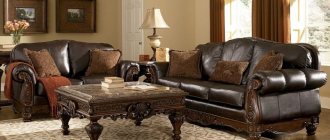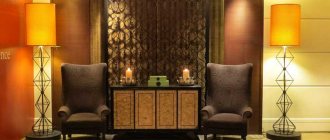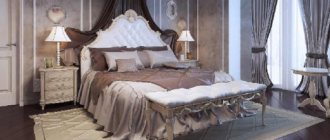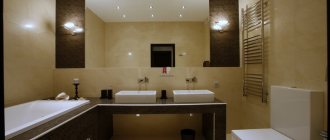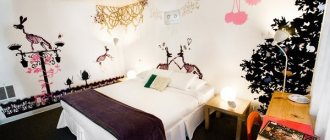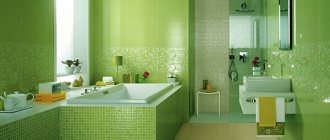Symmetry is the ideal style created by nature
Nature, the creator of all living things, is the most ardent supporter of symmetry. You only have to look in the mirror to understand this. The natural equality of the left and right sides is observed not only in the shape of the human body, but also in most animals, fish, many plants and microorganisms. Of course, nature also has exceptions - asymmetry, but it is in the minority.
It is not surprising that a person strives for symmetry in his surroundings. This desire has psychological prerequisites. A person feels more comfortable in a room where surrounding objects are arranged in an orderly manner and have a regular geometric shape.
Therefore, it is believed that in order to create an atmosphere of calm and maximum comfort in the house, it is necessary to maintain symmetry in the shape of pieces of furniture and in their arrangement, striving for an ideal balance.
Symmetry and asymmetry in the interior
All living things gravitate towards symmetry. This craving is caused by nothing more than the desire to taste the forbidden fruit, to accomplish what is impossible to accomplish, in a word, to go against chaotic nature. Such a system helps us and everything around us to live and function normally. Achieving balance in relation to material things is much easier, which is why the basis of design and architecture is the observance of compositional centers and symmetry. This symmetry does not necessarily include a complete mirror correspondence between the two halves of the room, that is, the element of imbalance is still preserved, but only conditionally. So, for example, heavy furniture in one half of the room may not be accompanied by an analogue on the other side; instead, objects from the other half of the room can be highlighted with a heavy color or texture. Let's look at examples of symmetrical and asymmetrical interiors in more detail. Symmetry in the interior A symmetrical interior is the lot of perfectionists. In order to please a nature striving for order, an avid conservative can make his interior perfectly proportional. The key components of this design is to install the compositional center exactly in the center of the room. First, choose a focal point in your room: the bed in the bedroom, the TV in the living room, or the stove in the kitchen. The center of the composition can also be a fireplace, a window or a painting on the wall. Divide the selected object vertically into two equal halves. The parts of the room located on both sides of this half should be mirror images of each other.
Advertising
This can be achieved with the help of paired items: two identical chairs on both sides of the sofa in the living room, identical hanging shelves in the kitchen, paired bedside tables near the bed in the bedroom, and so on. Objects such as a sofa or dining table can be placed directly on the center axis so that it passes through their middle.
When choosing a symmetrical design, remember that this solution is only suitable for a spacious or minimalist home, since symmetry puts the emphasis on the space itself, and not on the details within it. In pursuit of perfection, you should not strive for absolute symmetry, since this is not natural. Even our face, although it looks symmetrical, is actually not so. Asymmetry in the interior An asymmetrical interior, in contrast to a more formal, symmetrical one, is ideal for creative, active and modern people. Lively and very dynamic interiors, built against the rules of symmetry, always look interesting. Why does this happen? The basic component of an asymmetrical interior is the displacement of the compositional center in percentage terms, that is, if in a symmetrical interior the ratio of the halves is 50/50, then in a free and asymmetrical interior it can be approximately 60/40. The main thing in the asymmetry of the interior is the absence of a mirror effect.
Additional creativity is brought by corner sofas and a similar arrangement of furniture in general. A classic design example of creating asymmetry is the introduction of multi-level objects into the interior: a floor lamp on one side of the sofa in such a room is adjacent not to its own kind, but, say, to a lamp on a small cabinet; two armchairs can be similar in color, but differ in texture or design , the shelves in the kitchen can be made in the same style, but they will be filled with colored plates of different sizes, and so on.
It is worth noting that moderation should also be observed in asymmetrical designs. You should not fill the room with completely dissimilar objects, even if they are in one style, but different in color or material. https://recepton.com/
Secrets of using symmetry in the interior
Despite the fact that the human brain likes to see symmetrical objects, balance in the interior should not be abused. Imagine if every object in the room has its own mirror image - the result will be an overly saturated environment in which all elements will, as a rule, be paired, except for the central ones. There are reasonable limits for the symmetry of the situation and to obtain the ideal balance it is enough not to go beyond them. Designers have developed several ways to achieve symmetry and harmony in the space of a room:
Reflection - the role of the basis of the symmetry of the interior is played by the central furnishings, which bear the main stylistic load. This could be a fireplace in the central part of the room with armchairs in front of it, or a sofa, on either side of which there are identical bedside tables or tables, etc.
Rotation – the basis of the interior is made up of objects that have a central point around which their shape “rotates”. These are round or spherical elements, for example, chandeliers, tables, chairs.
Transitional forms are elements in which a form, decor or group of objects repeats the same pattern several times. For example, a parquet pattern, a pattern on a carpet or wallpaper.
Asymmetry is surprising, but it is with the help of asymmetry that you can emphasize the symmetry of the situation. Most suitable for this is a noticeable asymmetrical object, for example, an expensive work of art or a bright decorative element, which plays a primary role in the interior, but at the same time is designed to perform a special function, placing emphasis on the symmetry of secondary objects.
Using these design techniques and combining them, you can achieve the perfect balance in the interior, which will be perceived by the subconscious as ideal.
Symmetry in the interior: 16 techniques, tips from Laura Gaskill and 65 photo ideas
Professional decorators know that symmetry is good not only in classic interiors. In this practical guide you will see that its capabilities are much wider. And symmetrical furnishing elements can not only make the interior more attractive and impressive, but even correct the shortcomings of the room.
The American decorator-practitioner spoke about 10 ways to use symmetry as a main or auxiliary decorative tool. And we found 5 more plus 1 additional (for those who don’t like excessive rigor), and also selected suitable photographs of interiors and details. Discover new possibilities for symmetrical furnishings!
...Many elements of the world around us of various sizes are endowed with the property of symmetry: snowflakes, human faces, the Eiffel Tower... Therefore, it is not surprising that our gaze pays attention to the exact mirror image of interior items. Many people find this environment particularly harmonious and effective. Find out the reasons to use symmetry in your room decor and how to implement this interesting technique.
So first, 10 tips from Laura Gaskill. We presented them in accordance with the author’s logic, and you will find what will be appropriate in your interior.
1. Symmetry is indispensable when you want to add luxury and nobility to the room where you receive guests. For example, in the dining room or living room.
2. Symmetrical decor on both sides of the door turns entering the room into a real event . Any objects that inspire you are suitable for this - photographs, paintings, spectacular shelves, wall sconces, sculptures, plants (for example, topiary).
3. Symmetrical furnishings or decor make a small room feel larger . A work corner, a walk-through room or a small living room - all this can acquire additional charm and visual volume.
4. By using symmetrically placed furniture or decor in additional rooms (halls, wardrobe or bathroom), you automatically raise the level of its significance for your home. In addition, you assert your good taste, because you don’t have anything random.
5. Symmetrical accessories and furnishings draw attention to large architectural elements of the interior, creating the right balance . This creates a focal point for a room with well-thought-out decor.
6. Symmetry can do wonders for your art collection or other wall decor by drawing attention to the center of the composition. In a similar way, you can design your favorite piece of painting or a large photograph, adding small elements around it in a mirror image.
7. Symmetrical decor helps reconcile a modern TV with any interior style in which it previously seemed out of place (for example, traditional or ethnic). Now it is no longer perceived as a “big black box”.
8. Furniture positioned symmetrically relative to the chosen wall allows you to balance the eclectic approach to the choice of decor or your favorite collections placed on it.
9. And the opposite situation - symmetry helps to combine furniture from different styles. Here you need to work with the furniture itself, adding paired furnishing elements.
10. And the last observation of Laura Gaskill, it will appeal to fans of reasonable savings. Using symmetrical decor allows you to achieve a more chic look on a budget.
And 5 more of our observations:
11. Thanks to symmetry, you can form the main palette of the room or a combination of bright colors in it. Watch how leading decorators - Toby Fairley, Jay Jeffers and others - do it.
12. The interior of a room looks much more impressive if the color accents in it are located symmetrically relative to each other. This technique looks most advantageous when only one accent color is chosen. and the rest of the details are neutral. This is especially appropriate in the logical center of the living room or bedroom.
13. Draw attention to the most sophisticated furnishings by enhancing them with symmetry . The center of the composition can be just one object (for example, a console) or an entire area in the room (for example, for relaxation or communication). Reception is appropriate in halls, bedrooms and living rooms.
14. Symmetrical furnishings help define the logical center of the room , especially if it does not coincide with the geometric center or there are several zones in the room.
15. Paired interior details and mirrored pieces of furniture will highlight the style chosen for the main room of your home. In the photographs below you can see that symmetry as a decorative tool is perfect for living rooms in different styles .
And one more trick - for those who are afraid of excessive orderliness, sometimes characteristic of symmetrical interiors.
16. Diluted symmetry . It is sometimes called “divergent” if the level of specular reflection decreases with distance from the center of the composition.
Sometimes this is caused by natural reasons (shape of the room, length of the walls, etc.). But you can specifically work on the decor, diluting it with asymmetrical elements.
For example, add some kind of decorative element in the singular (pillow, picture, lamp, vase, plant, small plastic), photos 1, 4 and 9. Another option is a slightly different design of opposite walls in compliance with the color palette of the decor (photo 2 ). Or a slightly different size of the outermost paintings in the composition (photo 3).
You learned about 16 reasons to use symmetry in the interior. Where to start implementation? Designate the center of the composition around which you will build symmetrical furnishings and decor. Or a problem you want to solve. And then select the necessary elements. Try it, you will like it!
For other interesting techniques for a harmonious interior, see our section “Secrets of Decorators”.
